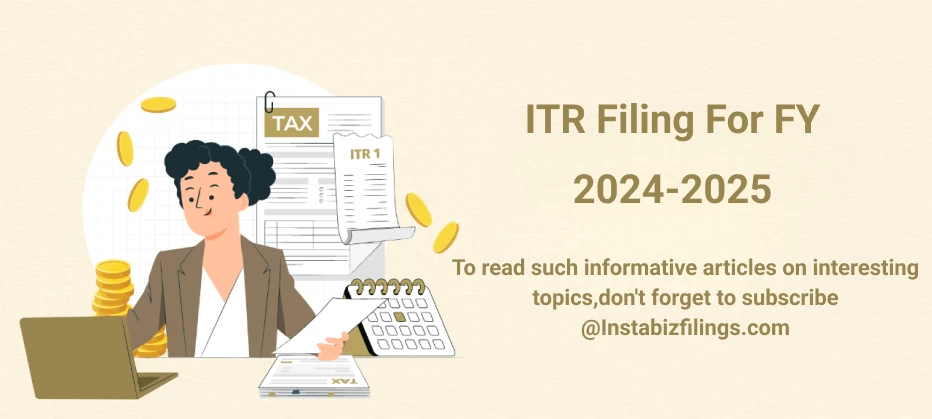
ITR Filing For FY 2024-2025
July 22, 2025 by Team Instabizfilings
Introduction
The Income Tax Return (ITR) is a compulsory legal requirement for every taxpayer in India. For the financial year (FY) 2024-25, from April 1, 2024, to March 31, 2025, and for the assessment year (AY) 2025-26, from April 1, 2025, to March 31, 2026, submandatory returns will be filed as per the financial year and assessment year. The compliance of ITR would not only be a symbol of financial discipline but would leave you eligible to obtain loans, claim back the charges and evade the penalty decrees by depositing the lastly filed ITR in time.
Who Should File ITR?
-
The amount you receive as total income is beyond the basic exemption threshold:
- There are a total of 2.5 lakh persons less than 60 years of age.
- The figure is 3 lakh (on ones aged between 60 -80)
- 5 lakh (to the persons who are over 80 years old)
-
The one who would wish to seek a refund of the TDS/TCS deducted.
-
One who has received capital gains, foreign assets or crypto transactions.
-
One who needs to submit to be allowed to pass on the losses using Section 139 (1).
-
You paid more than 1 lakh as an electricity bill or capitalised a bank account worth 1 crore or more.
-
Your expenditure in terms of foreign travel was more than 2 lakh.
Key Changes for FY 2024-25
-
Default Tax Regime: The common order remains the new tax regime (with the reduced slabs and no exception). Taxpayers may choose the old regime by filling it by a declaration of his choice.
-
Updated Form 16 & AIS/TIS formats: These come up with added disclosures which are transparent.
-
Crypto, ESOPs & Foreign Assets Reporting: Crypto, an employee stock ownership plan (ESOP), and foreign asset disclosures should be made with more vigorous requirements.
-
E-verification options: E-verification choices are simplified as Aadhar OTP, Net Banking, and DSC e-verification choices whereas Bank ATM e-verification choices are simplified.
Types of ITR Forms Applicable
|
ITR Form |
Applicable To |
|
ITR-1 (Sahaj) |
Salary income earners whose income does not exceed 50 lakhs, a single house property and absence of capital gains |
|
Individuals/HUFs who are having capital gain, multiple houses or foreign assets |
|
|
Individuals/HUFs with income from business or profession |
|
|
ITR-4 (Sugam) |
Presumptive income taxpayers as contained in section 44AD, 44ADA and 44AE |
|
Partnerships, LLPs |
|
|
Except for Companies which exempt themselves under Section 11. |
|
|
Trusts, Political Parties, Charitable Institutions, etc. |
ITR Filing Due Dates for FY 2024-25
|
Category |
Due Date |
|
Individuals & HUFs (Non-audit cases) |
July 31, 2025 |
|
Businesses requiring an audit |
October 31, 2025 |
|
Transfer Pricing cases (Form 3CEB) |
November 30, 2025 |
|
Belated or revised returns |
December 31, 2025 |
Documents Required for ITR Filing
-
Form 16 (employer)
-
AIS/TIS and Form 26 AS
-
Account information of the bank
-
Investment evidence (on deductions of 80C, 80D etc)
-
Capital gain certificates
-
Interest certificate home loans
-
Other income details: FD interest, rental income, etc.
How to File ITR Online
-
Sign In / Log In to Income Tax e-filing Portal
-
Select the option of filing an income tax return of DFA
-
In this case, choose the Assessment Year 2025-26
-
Select filing mode- Online or Offline
-
Choose the form of ITR
-
Enter details of incomes and deductions
-
Calculate tax and check through the Form 26 AS & AIS
-
e-verification and submission by Aadhaar-OTP, Net Banking or DSC
Penalties for Late Filing
|
Delay |
Penalty |
|
Filed after July 31 but before December 31 |
₹5,000 (₹1,000 if income < ₹5 lakh) |
|
Filed after December 31 |
May not be accepted unless condonation is granted |
Moreover, in case the taxes are paid after the deadline, then interest will be charged under Section 234A/B/C.
Benefits of Timely ITR Filing
-
Claim of TDS/TCS refunds
-
Forward gains or losses
-
Can be used to process visa, loans and credit cards applications
-
Prevent interest, penalties and investigation
-
Develops an excellent financial history
Tips for Smooth Filing
-
Apply early to prevent last last-minute rush.
-
Cross-reference Form 26AS, AIS and TIS.
-
Carry Form 16, bank statements.
-
Reconcile brokers with capital gains.
-
Select the proper tax regime - Old against New.
-
The 30-day ITR filing through e-verify.
Conclusion
You do not need to complicate your Income Tax Return Filing of FY 2024-25 when you know the procedure, keep in touch with the new amendments and keep your documents prepared. - Remember to file before the due date and seek the expertise of a tax expert where your case entails business income, foreign or capital gains assets.
Disclaimer
The information provided in this blog is purely for general informational purposes only. While every effort has been made to ensure the accuracy, reliability and completeness of the content presented, we make no representations or warranties of any kind, express or implied, for the same.
We expressly disclaim any and all liability for any loss, damage or injury arising from or in connection with the use of or reliance on this information. This includes, but is not limited to, any direct, indirect, incidental, consequential or punitive damage.
Further, we reserve the right to make changes to the content at any time without prior notice. For specific advice tailored to your situation, we request you to get in touch with us.


